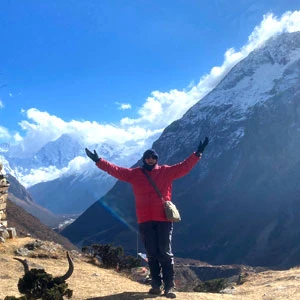Ama Dablam Base Camp With Gokyo Valley Trek Overview
The Ama Dablam Base Camp with Gokyo Valley Trek is a compelling blend of high-altitude adventure that combines two iconic routes: Ama Dablam Base Camp and Gokyo Valley via Renjo La Pass. This trek takes you through the heart of Nepal’s Khumbu region, to the foot of the sacred Ama Dablam (6,812 meters), and into the remote, glacier-carved landscapes of Gokyo Valley.
If you're seeking more than just Everest views, this route offers spiritual serenity, dramatic mountain vistas, and authentic encounters with the Sherpa way of life. Historically, the Gokyo Valley route began gaining attention in the early 1980s, as trekkers started venturing off the beaten path to explore the pristine lakes and glacial valleys west of the Everest trail.
Unlike Everest Base Camp, Gokyo Valley remained largely untouched by commercial trekking until the mid-1980s. Meanwhile, the trail to Ama Dablam Base Camp evolved quietly over the years.
The route to Ama Dablam was primarily used by mountaineers to summit the mountain after Sir Edmund Hillary’s Everest ascent. Although Ama Dablam itself was first climbed in 1961, the base camp trek became accessible only in the late 1990s.
Scenic Landscapes and Cultural Richness
This Ama Dablam Gokyo Valley trek takes you through diverse landscapes: lush pine forests, rhododendron-covered hills, high-altitude villages, and glacial valleys. It delivers some of the most breathtaking views in the entire Himalayas with a less trafficked route.
Culturally speaking, this trek passes through a living museum of Sherpa heritage, whose roots trace back over 500 years when they migrated from eastern Tibet into Solukhumbu. Along the way, the influence of Tibetan Buddhism is evident everywhere.
A fun fact: Ama Dablam, in Sherpa cosmology, represents a mother’s outstretched arms offering protection. Also, its name translates to "Mother’s Necklace," a reference to the hanging glacier resembling a pendant.
Start of The Trek
The journey to Ama Dablam Base Camp and Gokyo Valley begins with a short but breathtaking flight to Lukla, the gateway to the Khumbu region. This flight delivers views of the valleys below, snow-capped peaks, and hillsides, before landing at Lukla’s airport which is dramatically perched on a mountainside.
From Lukla, you will descend through pine forests and stone-paved paths, tracing the banks of the Dudh Koshi River. You will pass small settlements like Chheplung and Ghat, before finally reaching Phakding, a peaceful riverside village surrounded by terraced hills and fluttering prayer flags.
Phakding offers your first introduction to Sherpa hospitality, with cozy tea houses and mani stone walls. It is a popular stop for Everest trekking and most of the locals here belong to the Sherpa and Tamang communities, whose roots and traditions are deeply tied to Tibetan Buddhism. At the heart of the village, you will see a small yet sacred Gompa (monastery), where locals gather to chant prayers and light butter lamps.
From Phakding, you will then gradually climb through lush forests of rhododendrons, fir, and magnolia, crossing several suspension bridges adorned with colorful prayer flags. Here, you will also cross one of the highest and most iconic bridges, the Hillary Suspension Bridge.
Soon, you will arrive at Namche Bazaar, the largest Sherpa town and commercial center of the region. As you step within Namche surrounded by towering peaks, you will find yak caravans, bakeries, internet cafes, and local markets.
Historically, Namche is a trading post between Nepal and Tibet. Even today, every Saturday morning, this village springs to life with a weekly market, where traders from nearby settlements come to exchange goods. Beyond its commercial charm, Namche is also a place for acclimatization.
During your time here, you will have the opportunity to explore the bazaar, visit cozy cafés, check out local museums, or simply marvel at your first unobstructed views of Mount Everest and surrounding peaks.
After acclimatizing in Namche, you will take the uphill trail along ridgelines in Mong La Danda offering views of Everest, Lhotse, Tawache, Nuptse, and most strikingly, Ama Dablam.
Passing through rhododendron forests and alpine meadows, you will then reach the tranquil village of Tengboche, home to the revered Tengboche Monastery. From here, you will also get to witness undisturbed views of Ama Dablam, Thamserku, Kangtega, Everest, Lhotse, and many more.
This village maintains a profound spiritual connection to the Himalayas. They are grounded in Tibetan Buddhism and center around the Tengboche Monastery. Framed against a backdrop of soaring peaks, Tengboche monastery houses 60 monks. Monks here are dressed in crimson robes and chant ancient mantras. Altogether, this monastery is decorated with ancient mani walls and prayer flags.
If your timing is right, you may witness the annual Mani Rimdu Festival in November. At this time of the year, the village bursts with colorful masked dances and sacred ceremonies, honoring both the mountains and the spiritual guardians believed to protect climbers. This celebration takes place for five days in total.
Reaching Ama Dablam Base Camp
From Tengboche, you will continue the journey toward Pangboche, one of the oldest and highest permanent Sherpa settlements in the Khumbu. This village is located within the Imja Khola Valley and is the base camp for climbing Ama Dablam.
While in Pangboche, you will witness centuries-old monastery houses, relics, and texts that are believed to be linked to the Yeti legend. The village offers stunning views of Ama Dablam, and the locals are often descendants of the original Sherpa migrants.
As you leave the quiet, stone-built village of Pangboche, the trail to Ama Dablam Base Camp begins with a gradual descent through alpine meadows and open yak pastures. It then climbs steadily along a rugged ridge that leads you toward the base of Ama Dablam.
Here, the terrain is a mix of narrow rocky paths, loose scree sections, and some steeper inclines. Along the way, you may spot Himalayan thar, snow pigeons, or even the elusive musk deer.
As you arrive at Ama Dablam Base Camp, you will be rewarded with jaw-dropping views of Ama Dablam itself with Everest, Lhotse, Nuptse, and Kangtega in the distance. This base camp is set on a broad, flat expanse of rocky grassland surrounded by towering cliffs and glacial moraines.
Trekking Towards Gokyo Valley
After reaching the base camp, you will again come back to Pangboche before taking an unconventional turn away from the busy Everest route toward the less-trodden village of Phortse. Often overlooked, Phortse is a hidden gem perched on a hillside and is known for producing some of Nepal’s most accomplished mountaineers.
The route to this village is quite secluded and Phortse itself is surrounded with forests of juniper and rhododendron. Here, Phortse is also home to the Sherpas, the well-known mountaineers of the world. Their intimate knowledge of the mountains and centuries-old mountaineering traditions have made them essential partners to countless Everest expeditions.
Passing Phortse, you will have two route options to reach Gokyo: via Dole or via Thare. The right-side route via Thare is more secluded with fewer crowds but the path can be more difficult and untamed. Similarly, the left side route via Dole is more managed but you may encounter a few trekkers along the way.
To trek via Dole, you will need to ascend through alpine terrain. Dole is a tranquil village nestled in a hanging valley surrounded by waterfalls and grazing yaks. Climbing higher from here, you will pass Lhabarma and Luza, where the air gets thinner and the landscape turns stark and dramatic.
The route then brings you to Machhermo, a wind-swept village with a tragic past. Back in 1974, a massive avalanche struck the village which left devastating damage. Today, Machhermo is also known for the myth of the Yeti, and while in here, you will hear legends passed down through generations.
Next, you will reach the stunning Gokyo Valley which is home to the sacred Gokyo Lakes. These lakes are among the highest freshwater lakes in the world and are considered holy by both Hindus and Buddhists. The largest lake, Dudh Pokhari, sits beside Gokyo Village, a remote outpost of stone lodges and yak herders.
While in Gokyo, you will prepare for one of the trek’s most rewarding experiences: the pre-dawn climb up to Gokyo Ri (5,357 meters). The view from the summit is nothing short of breathtaking with an unbroken chain of the world’s tallest peaks, including Everest, Cho Oyu, Lhotse, and Makalu.
To reach this viewpoint, you will trek up a rocky ridge with loose gravel underfoot. As you climb higher, the air thins, and the temperature drops, but the landscape becomes ever more dramatic. About halfway up, you will witness a series of rock cairns and fluttering prayer flags. Likewise, the final stretch of the climb is tough but steady.
The Crossing of Renjo La Pass
From Gokyo, you will make your way towards Lungdhen via its adventurous climax with the crossing of Renjo La Pass (5,360 meters). The ascent to this pass is steep and often snow-covered, but the panoramic view from the top is breathtaking as it overlooks the entire Gokyo Valley and beyond.
You will begin the ascent to Renjo La Pass from the western edge of Dudh Pokhari. Here, the terrain quickly becomes steeper and more rugged as you begin climbing toward the pass. The air is thin, and progress is slow, with each step revealing more of the surrounding peaks.
Along the way, you will pass large boulders, alpine meadows, and icy stream crossings. As you near the top of the pass, the landscape becomes barren and dramatic. But once you reach the top, you are treated to one of the finest panoramic vistas in all of the Himalayas. 99
From here, the descent takes you into the remote Bhote Koshi Valley, where you will pass through Lungdhen, a sleepy village with Tibetan roots. The village itself is small with a handful of traditional stone lodges and homes scattered along a rugged slope.
The residents are mostly Sherpa and Tibetan descendants who have lived in the region for generations. Here in Lungdhen, you will witness prayer flags fluttering across each rooftop, stone mani walls carved with Buddhist inscriptions, and occasional chortens that dot the landscape.
The surroundings here are arid and wind-swept, with dramatic ridgelines, dry grasslands, and views of distant peaks like Cho Oyu and Cholatse. The Bhote Koshi River gurgles down the valley below.
Leaving this village behind, the trail eventually reconnects with the Everest route near Namche, and from there, you retrace your steps back to Lukla.
Why Ama Dablam Base Camp with Gokyo Valley Trek instead of the Everest Base Camp?
Choosing the Ama Dablam Base Camp with Gokyo Valley Trek over the traditional Everest Base Camp (EBC) route offers a more serene, scenic, and culturally immersive Himalayan adventure. While the EBC trek is iconic and undoubtedly popular, the route often becomes congested, especially during peak trekking seasons. In contrast, the Ama Dablam and Gokyo Valley trail leads you through quieter and less-trodden paths within the Himalayas.
One of the unique draws of this trek is that you still get to visit a dramatic Himalayan base camp, Ama Dablam Base Camp, without the overwhelming foot traffic of Everest Base Camp. You will likely share the trail with only a handful of other trekkers.
Similarly, the Gokyo Valley section adds even more magic to the journey. Instead of retracing a linear trail like EBC, you will get to explore a circular route that crosses the high Renjo La Pass and opens into the majestic Gokyo Lakes. Climbing Gokyo Ri rewards you with one of the most breathtaking Himalayan panoramas, offering views of Everest, Lhotse, Makalu, and Cho Oyu in one sweeping gaze.
Moving on, the cultural experience is equally rich. You will pass through authentic Sherpa villages, where life remains deeply rooted in tradition. Unlike the busy tea-house chains you will find along the EBC route, these villages offer a more personal and grounded feel.
Furthermore, the physical challenge is well-balanced. While the trek takes you to high altitudes, including the Renjo La Pass at over 5,300 meters, the balanced itinerary with acclimatization days makes it bearable.
In short, if you are looking for stunning mountain scenery, fewer crowds, meaningful cultural interaction, and a genuine Himalayan wilderness experience, then the Ama Dablam Base Camp with Gokyo Valley Trek is a compelling and fulfilling alternative to Everest Base Camp.



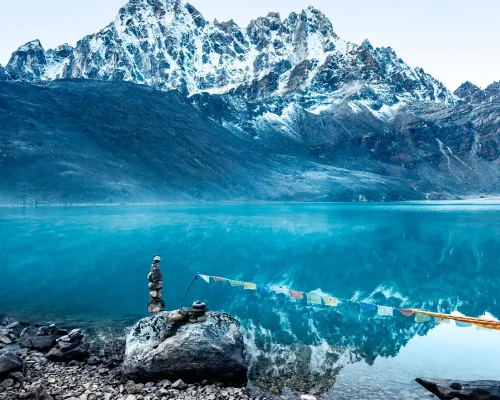

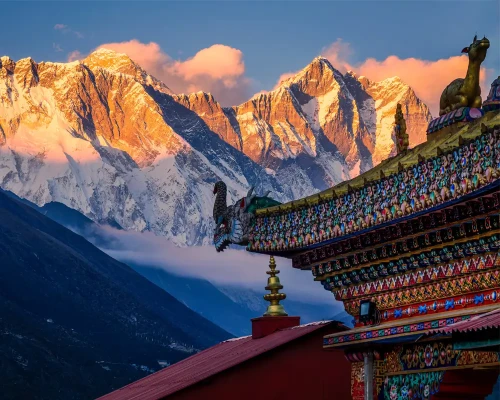
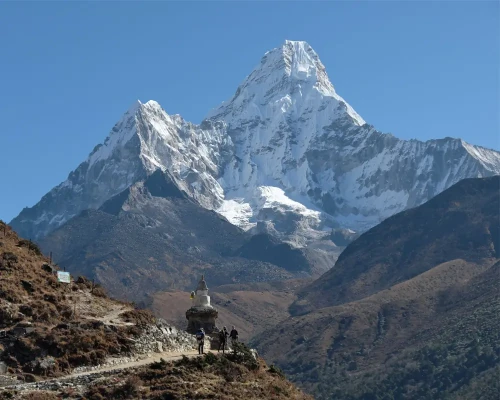

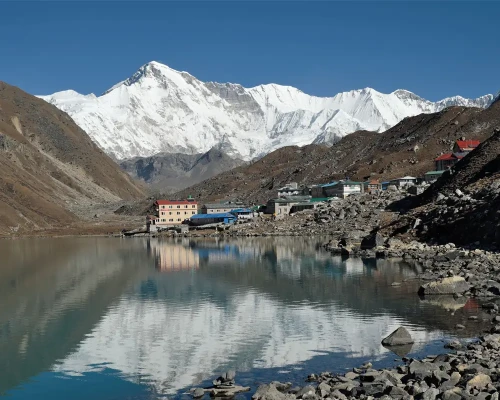

 based on 32 reviews
based on 32 reviews


